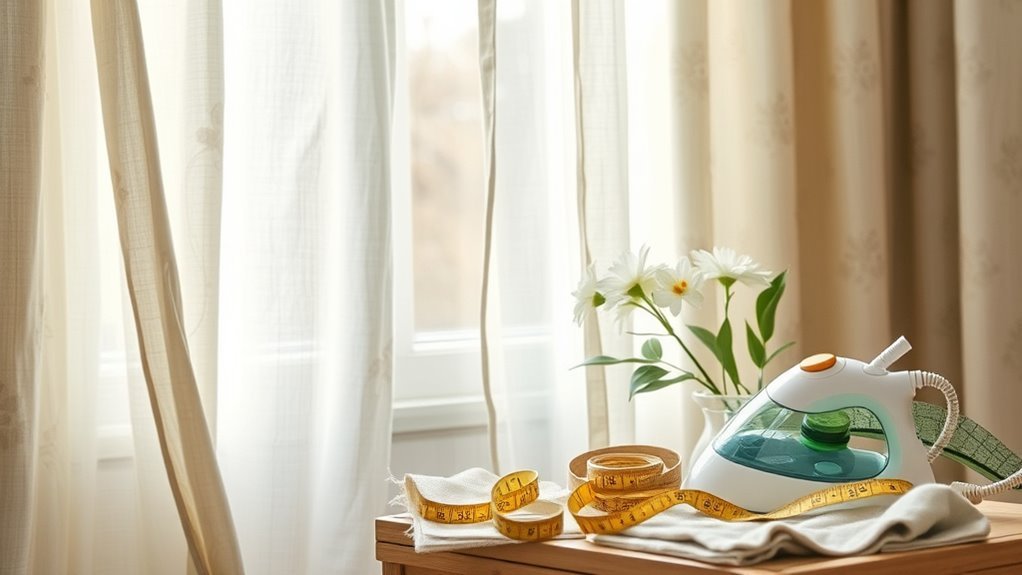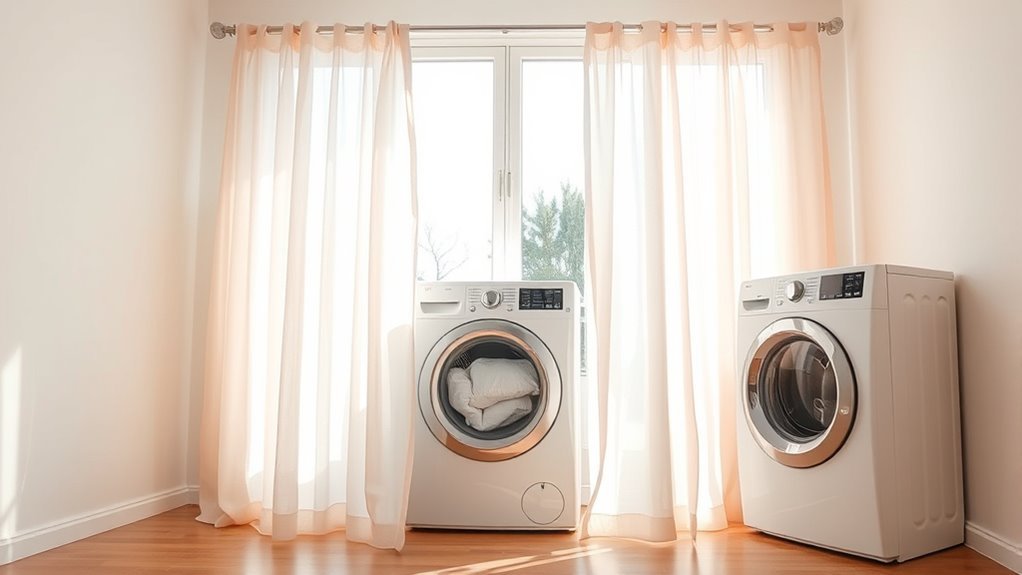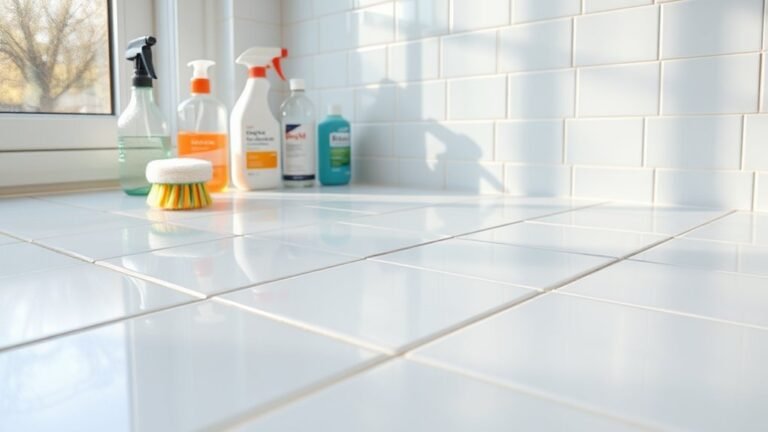Spring Cleaning Guide for Curtains
For spring cleaning your curtains, start by checking the fabric type and care label to choose the right washing method—machine wash delicate fabrics on gentle cycles or hand wash with mild detergent. Remove hooks, vacuum to clear dust, and repair any tears first. Spot clean stains carefully and air dry promptly to prevent wrinkles. Regular airing and dusting between washes keep curtains fresh longer. To master these steps and prolong your curtains’ life, you can explore more detailed tips.
Assessing Your Curtain Fabric and Cleaning Requirements

Before you begin cleaning your curtains, it’s important to identify the fabric type and understand its specific care needs. Different fabric types—like cotton, linen, silk, or polyester—demand unique cleaning methods. Check the care label for cleaning symbols that guide you on water temperature, bleach use, and drying instructions. These symbols are your roadmap to avoid damage or shrinkage. Natural fibers often require gentler handling, while synthetics can usually tolerate machine washing. If the label’s missing or unclear, test a small hidden area first. Knowing your curtain’s fabric type and following the cleaning symbols guarantees you maintain their quality and appearance, freeing you from guesswork and potential mishaps. This step sets the foundation for a smooth, efficient curtain cleaning process. Additionally, regular cleaning and maintenance help prevent buildup of dirt and odors, ensuring your curtains stay fresh and last longer.
Preparing Curtains for Cleaning
Once you know your curtain’s fabric and care requirements, you can start preparing them for cleaning. Begin by removing hooks and hardware carefully. Check for any tears or damage to mend before washing. Vacuum curtains gently to eliminate dust. Sort curtains by curtain types and fabric care needs to avoid damage. Proper organizing and decluttering before cleaning can help ensure a smoother process.
| Curtain Type | Fabric Care Tips | Pre-Cleaning Step |
|---|---|---|
| Sheer | Hand wash or gentle cycle | Remove hooks, vacuum |
| Linen | Dry clean or gentle wash | Check for stains, mend |
| Cotton | Machine washable | Sort by color, vacuum |
| Velvet | Dry clean only | Brush surface, mend holes |
| Synthetic | Machine washable, cold water | Remove hooks, vacuum |
This systematic prep guarantees freedom from damage and ideal cleaning results.
Machine Washing Curtains Safely

Although machine washing curtains can save time and effort, you’ll need to follow specific steps to prevent damage. First, check the care label to identify fabric types—cotton, polyester, or blends are usually machine washable, while delicate fabrics like silk or velvet require special care. Use a gentle washing cycle to minimize stress on the material. Select cold or lukewarm water to avoid shrinking or color fading. Remove hooks and weights before placing curtains in a mesh laundry bag to protect them during the wash. Avoid heavy detergents and opt for mild, eco-friendly options. Once washed, hang curtains immediately to air dry, preventing wrinkles and preserving their shape. By following these steps, you maintain your curtains’ quality while enjoying the freedom of hassle-free cleaning. Additionally, adopting a consistent care routine helps preserve the fabric’s appearance and longevity over time.
Hand Washing and Spot Cleaning Techniques
If you’re dealing with delicate curtains or small stains, hand washing and spot cleaning are your best options. Hand washing lets you control water temperature and detergent use, protecting fabrics. For spot cleaning, always test a small hidden area first to avoid damage.
| Task | Technique | Tips |
|---|---|---|
| Hand Washing | Use lukewarm water | Gentle detergent, soak 10 mins |
| Spot Cleaning | Dab with mild soap | Blot, don’t rub, air dry |
| Stain Removal | Use vinegar mix | Apply carefully, rinse well |
| Drying Prep | Squeeze gently | Avoid wringing, preserve shape |
Stick to these methods, and your curtains will stay fresh without risking damage. Regular maintenance like seasonal cleaning helps prevent buildup and extends the life of your curtains.
Drying and Ironing Curtains Properly

While drying curtains, you’ll want to avoid direct sunlight to prevent fading and fabric damage. Instead, hang them in a well-ventilated area or use a drying rack indoors. Different fabric types require distinct curtain care: delicate fabrics like silk or lace should air dry flat or hung loosely, while sturdier cotton or polyester curtains can tolerate gentle tumble drying. When ironing, always check the fabric type and care label first. Use the lowest heat setting for synthetics and a medium setting for cotton or linen. Iron curtains while slightly damp for best results, and iron on the reverse side to avoid shine or damage. Proper drying and ironing not only maintain your curtains’ look but also extend their lifespan, giving you the freedom to enjoy fresh, vibrant window treatments longer. Additionally, testing a small hidden area before ironing can prevent accidental damage by ensuring fabric colorfastness and reaction.
Removing Stains and Odors Effectively
How do you tackle stubborn stains and lingering odors on your curtains? Start by identifying the fabric type to choose the right stain removal method. For washable curtains, gently blot stains with a mixture of mild detergent and warm water—avoid rubbing to prevent damage. For tougher stains, apply a fabric-safe stain remover, following product instructions carefully. To eliminate odors, sprinkle baking soda over the curtains and let it sit for 15-30 minutes before vacuuming it off. Alternatively, use a fabric refresher spray designed for odor elimination. Always test any product on a small, hidden area first. By systematically addressing stains and odors with targeted solutions, you’ll restore your curtains’ freshness and extend their life while keeping your space inviting and free. Using natural cleaning solutions like baking soda not only removes odors but also avoids harsh chemicals, promoting a healthier home environment.
Maintaining Curtain Freshness Between Cleanings
To keep your curtains fresh between deep cleanings, make a habit of regular dusting using a vacuum with a brush attachment or a lint roller. Opening your windows to air out the curtains helps reduce odors and moisture buildup. These simple steps will extend the time between washes and keep your curtains looking crisp. Additionally, regular maintenance can help prevent issues like moisture buildup which may lead to mold and mildew growth on fabric surfaces.
Regular Dusting Techniques
Regularly dusting your curtains is key to keeping them fresh and extending the time between deep cleanings. To maintain effective curtain care, start by using a handheld vacuum with a soft brush attachment. Gently run it over the fabric, reaching folds and hems to remove dust buildup. Alternatively, a microfiber duster can trap dust without damaging delicate materials. Aim to dust your curtains at least once every two weeks to prevent heavy dust accumulation. This consistent dust prevention reduces allergens and maintains fabric vibrancy. Remember to handle curtains gently to avoid stretching or snagging. By incorporating these straightforward dusting techniques into your routine, you free yourself from frequent, intensive cleaning sessions while preserving the look and longevity of your curtains with minimal effort.
Airing Out Curtains
Although dusting helps reduce allergens, airing out your curtains is essential for maintaining their freshness between cleanings. Seasonal airing lets trapped odors and moisture escape, keeping your curtains vibrant and odor-free. Simply draw your curtains open fully on a breezy day, allowing fresh air to circulate. Avoid direct sunlight for delicate fabrics to prevent fading.
| When to Air Out | How to Air Out |
|---|---|
| Early spring | Open windows, draw curtains wide |
| After cooking or shower | Open nearby windows, ventilate |
| Regularly every month | Use a fan or air purifier near |
Incorporate seasonal airing into your routine for lasting curtain freshness without hassle. This simple step extends the life of your window treatments and keeps your space feeling free and fresh.
Frequently Asked Questions
How Often Should I Replace Curtains Instead of Cleaning Them?
You should consider replacing your curtains every 5 to 7 years, depending on their curtain lifespan. Look for replacement signs like fading colors, persistent odors, fabric thinning, or damage that cleaning can’t fix. If your curtains no longer enhance your space or affect your mood negatively, it’s time for new ones. Staying practical means balancing upkeep with timely replacement, giving you freedom from constant maintenance and a fresh look.
Can Cleaning Curtains Improve Indoor Air Quality?
Yes, cleaning your curtains can definitely improve indoor air quality. Over time, curtains trap dust mites and curtain allergens that circulate in the air, which can trigger allergies or respiratory issues. By regularly washing or vacuuming them, you reduce these irritants, making your home feel fresher and healthier. Keeping curtains clean lets you breathe easier and enjoy a more comfortable living space without unnecessary airborne pollutants.
What Are Eco-Friendly Alternatives to Chemical Curtain Cleaners?
Imagine your curtains as a canvas, ready to be refreshed without harsh chemicals. You can embrace natural cleaning by mixing vinegar and water for a gentle spray or crafting a baking soda paste to tackle stains. These DIY solutions are simple, effective, and let you reclaim control over what touches your fabrics. By choosing these eco-friendly methods, you free yourself from toxins while keeping your home fresh and inviting.
How Do I Prevent Curtains From Fading in Sunlight?
To prevent your curtains from fading in sunlight, you’ll want to focus on fabric choices that naturally resist UV damage, like polyester or acrylic blends. Additionally, consider applying UV protection sprays designed for fabrics to extend their lifespan. You can also use lined curtains or add a sheer layer underneath to block direct sunlight. These steps help maintain vibrant colors while giving you freedom to enjoy natural light without worry.
Are There Special Considerations for Cleaning Blackout Curtains?
Did you know that 65% of people say blackout curtains improve their sleep quality? When cleaning blackout curtains, you’ve got to treat the blackout fabric gently. Avoid harsh detergents and don’t machine wash unless the label says it’s safe. Instead, vacuum regularly and spot-clean with mild soap and water. If you must wash, use a gentle cycle and air dry to preserve the fabric’s light-blocking properties and extend its life.






